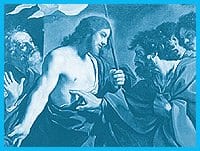Say what you like about the Catholic Church, they sure know how to put on a show. You want gold? The Vatican could have built the Chunnel out of the surplus they keep in storage. Silver? More plentiful than lawsuits. Pearls, gems, platinum, ivory and diamonds? That’s the stuff the help eats off.
Scandals, corruption, idiotic policies and doddering popes may come and go, but the world’s oldest theatre troupe still lays on the glitter better than a busload of Nevada hookers.
Witness the selection of the church’s treasures on display at the Royal Ontario Museum, Images Of Salvation: Masterpieces From The Vatican And Other Italian Collections – a less-than-zero percentage of The Vatican’s holdings – and you’ll understand how Mother Church stays big mama century after century.
As they say on Bay St, the winner is the guy with the most stuff. And Images Of Salvation couldn’t be better timed in PR terms, as it re-positions the church as a timeless entity – a preserver of Christian heritage and dignity, the polar opposite of its current tawdry status as the butt of Letterman wisecracks and tabloid headlines.
If today’s church is behaving like Bill Clinton, its art collection is the Queen Mum. Only a cynic would imagine the timing of Images Of Salvation is anything more than coincidence.
But picking on the ROM’s beautiful, smartly staged exhibition out of spite for the church is not only petty, it’s intellectually lazy. The art on view in Salvation transcends the mundane, which is exactly what liturgical art is supposed to do.
The exhibit opens with Mazzanti’s Ecstasy Of St Giusseppi, a lively, almost irreverent depiction of the saint’s fabled moment of rapture. Surrounded by his fellow monks, Giusseppi flies up into the clouds, where a milk-faced chorus of winged angels linger like accident gawkers. The busy, multiple perspective construction of the painting and its use of comic book-style foregrounding brings the hapless monk’s big moment into vibrant, kinetic life. Farther down the hall, Giusseppi’s take off is ornamented by a sugary series of large oil on canvas studies of curly headed cherub faces – faces so cheerful, so pudgy and pink, they belong on Gerber’s bottles.
Side by side, the paintings are a delight, a puckish opener to an often somber show. But these wonders are only the lobby act. After you pass the third layer of security (many of these works are post-priceless), the real show begins.
Many historical exhibits seem cramped and overcrowded, too much like a very pricey rummage sale, but Salvation emphasizes quality over quantity. You will come away dazzled, not dazed. Organized loosely around biblical themes and indirectly by chronology, the works are evenly displayed in a generous, comfortable setting. As the show unfolds, it also acts as a directed tour of the church’s long process of erasing its pagan heritage.
For instance, one of the first works on view is a 14th-century marble relief depicting the creation of Eve. Graphically blunt – Eve emerges from Adam’s ribcage like a woozy baby calf (or like Dionysius from Zeus’s thigh) – the relief is both reverent and bracingly earthy. Compare this work to a later painting a few cubicles down of the same scene, one in which Eve appears to be merely snuggling with Adam, and you can sense the medieval uncertainty – calmed by the Renaissance – over its own trashy polytheistic origins.
With each successive era, the viewer becomes aware of a gradual Disneyfication of the Bible’s often grisly tales; the nadir being a selection of 19th-century gilded wood statues of the Apostles, who look more like DC superheroes than men of conscience.
Being a book nerd, I kept going back to the amazing collection of illuminated manuscripts, many of them made as early as the 13th century. A single page of text must have taken weeks of work and could only have been done with brushes the size of pen tips. One page illustrates the seven days of creation with a narrow chain of breathtakingly intricate medallions no bigger than quarters (God looks charmingly like an aging heavy metal singer surveying his estate).
The Hebrew bibles are even more elaborate; each page is heavy with gold and vermilion and the lattice-work imagery appears to have been built layer by lacquered layer. If you’re the kind of person who marvels over those “Your face on a grain of rice” paintings, they’ll have to drag you away from the bibles. I still have bruises on my shoulders.
Although I doubt it’s intentional, Salvation has a lot to say to the queer viewer. The centrepiece of the exhibit is a small but gorgeous selection of Michelangelo’s Sistine Chapel sketches. Softly lit (to protect them from damage), the sketches sit high and holy on the walls like precious icons.
It is a rare treat to see these works up close, because they say so much about Michelangelo’s processes. Note the sketches depicting Adam’s expulsion from The Garden – Adam’s hands are raised like shields, his fingers curl like warm wax under God’s menacing glare. Fraught with tension and fear, the expulsion sketches show how Michelangelo perceived emotion as a corporeal event. You can see poor Adam’s terror in every twitching, hunky muscle. Perhaps the conservative forces in the church advocating a queer purge should be made to list all the glorious Catholic art created by fags – starting with the Sistine Chapel.
Other queer bell ringers are a statue of a very twinky St Sebastian doing his “stop/don’t stop” routine with the arrows, Guercino’s gruesome painting of St Lucy carrying her own eyeballs on a silver platter, Castello’s Stoning Of St Stephen, featuring a sissified, pink robed Stephen set upon by a Pasolini-esque gang of loin clad toughs, and Guercino’s deliciously erotic The Incredulity Of St Thomas, wherein a bearish Thomas questions the validity of the Resurrection by fingering pretty boy Christ’s bare, creamy torso. Sure beats all those hours I spent in United Church Sunday school learning “Jeremiah Was A Bullfrog.”
Considering the state of Catholic affairs (no pun intended), Salvation could be a little less reverential in tone. The cheesy, haloed portrait of chief bigot John Paul II reminds the viewer that the Vatican is not only the major sponsor, but also the chief propagandist.
The texts that accompany the works often struck me as arrogant and preachy, reading more like catechism lessons than informative panels. On a practical level, the purpose of many of the ecclesiastical items on display will be lost to the uninitiated, especially non-Christians. Several times I found myself standing in front of some stunning, gilded object saying, “Yes, it’s pretty, but why was it made and what do you do with it?”
There is no doubt that Salvation is jam packed with spectacular works, but the masterpiece quality of the art should not be used as an excuse to exclude dialogue about the art’s messages or its relevance in a changed world. Instead of giving us a chance to learn or think, Salvation merely asks us to listen without question.
Isn’t that the whole problem?
* Images Of Salvation.
$10-$18. Till Sun, Aug 11.
Royal Ontario Museum.
100 Queen’s Park.
(416) 586-5549


 Why you can trust Xtra
Why you can trust Xtra


